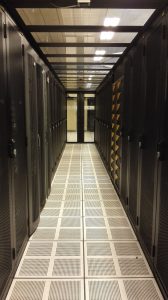
Knowledge Base / News
Many smaller organizations that don’t have the space or budget for their own data center will opt to host their servers with a colocation provider. This helps them keep their servers in a reliable data center facility at a lower cost than providing their own local power, cooling, and bandwidth.
The lower cost of using a colocation provider comes with some tradeoffs, however. When you colocate your servers, you may not have immediate physical access to them (or you may not have access at all, depending on your service level). You also don’t have much control over bandwidth if it’s provided by the colocation facility, and you definitely have no control over their environmental factors such as power, heating, and cooling.
 Your monitoring needs vs. the data center’s monitoring needs
Your monitoring needs vs. the data center’s monitoring needsStats are usually provided by your colocation facility when it comes to your power use and bandwidth, so you have an idea on the amount of electricity your servers or racks are using, along with how much internet access your inbound traffic is requiring. Far rarer are statistics on temperature and humidity levels near your colocation space, along with statistics on room entry or the possibility of water/liquid being detected.
Of course, managed data centers are often monitoring those environment factors… however they’re usually monitoring them for their own knowledge and benefit. Data center engineers need to know if temperatures or humidity have exceeded certain thresholds so they can address them, however they may not be reporting those alerts to their customers.
Your colocation provider may also be placing their monitors and sensors in locations that are most important to them, not you. Environment factors like temperature, humidity, and water near your space can impact you directly, however your colocation facility’s monitoring may not be picking them up accurately based on their own sensor locations.
If your organization is in a position where you are looking to colocate your servers in a managed facility, or if you are looking for a new colocation provider, be sure to ask them if environmental monitoring is included in the statistics they will be providing to you. If environment monitoring is included, be sure to ask if their monitors and sensors are located in close proximity to your assigned space.
In the event that environment monitoring is not provided to you by your colocation provider or you’d like to augment what they do provide, at the very least you should be monitoring temperature, humidity, and flood around your equipment. Placing temperature sensors at the top of your rack is recommended to gauge an accurate reading to help you ensure your equipment is not in danger due to high temperatures.
Humidity sensors should also be placed near your temperature sensors (or you can opt for a dual temperature/humidity sensor) as humidity can cause just as much damage and data loss as high temperatures.
If your colocation facility allows customer access, unfortunately you cannot control the other tenants’ behavior nor can you control what they bring in to the data center. Although many facilities have a strict “no food or beverages” policy, finding discarded extra-large soft drink cups in the garbage the morning after an off-hours client visit is fairly common. To help protect your data and equipment, a flood sensor with the cable wrapped around your rack or cabinet can help immediately alert you if water or liquid is detected on the floor.
Based on the type of environment monitoring you opt to install, you may even have the ability to have notifications of environment concerns sent directly to the data center’s support group, in addition to notifying your own staff. If your colocation facility isn’t immediately near your own office, it may be faster and better for data center employees onsite to check the causes of your environment alarms. If your chosen data center isn’t a manned facility, notifying your staff of environment issues may mean you’re first onsite to help mitigate any issues and provide damage control for your equipment.
Opting to host your servers in a managed colocation data center can provide a wide range of benefits to your organization at a lower price point than building your own data center. Colocation is often a smart option for smaller organizations who need a budget-friendly option to host their own servers. Just as you would with any other investment, it’s important to manage and protect your servers with both security monitoring and environmental monitoring.
By installing and managing your own environment monitors, you’ll be providing an extra layer of protection against the factors that cause almost 30% of outages and data loss.

You may find Windows Command Prompt at the following path:
To run Windows Command Prompt as an administrator:
| Current S models | Current E models |
|---|---|
| Room Alert 32S | Room Alert 32E |
| Room Alert 12S | Room Alert 12E |
| Room Alert 3S | Room Alert 4E |
| Room Alert 3E | |
| S models | E & W models |
|---|---|
| Room Alert 32S | Room Alert 32E |
| Room Alert 12S | Room Alert 12E |
| Room Alert 3S | Room Alert 4E |
| Room Alert 3E | |
| Room Alert 3W |
| Model |
|---|
| Room Alert MAX |
| Room Alert 32S |
| Room Alert 12S |
| Room Alert 3S |
| Room Alert 32E/W |
| Room Alert 12E |
| Room Alert 4E |
| Room Alert 3E |
| Room Alert 3 Wi-Fi |